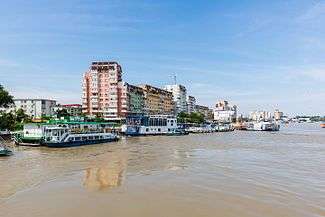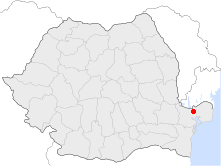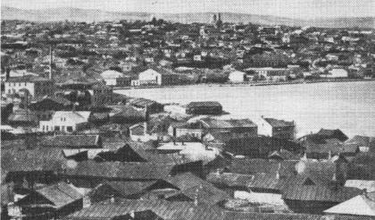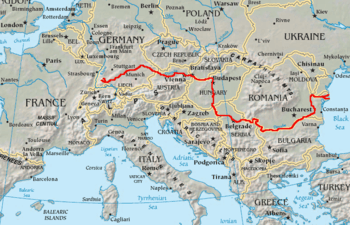Tulcea
| Tulcea | ||
|---|---|---|
| County capital | ||
 | ||
| ||
 Location of Tulcea | ||
| Coordinates: 45°11′24″N 28°48′0″E / 45.19000°N 28.80000°ECoordinates: 45°11′24″N 28°48′0″E / 45.19000°N 28.80000°E | ||
| Country | Romania | |
| County | Tulcea County | |
| Status | County capital | |
| Government | ||
| • Mayor | Constantin Hogea (Democratic Liberal Party) | |
| Area | ||
| • Total | 177.24 km2 (68.43 sq mi) | |
| Population (2011)[1] | ||
| • Total | 73,707 | |
| • Density | 416/km2 (1,080/sq mi) | |
| Time zone | EET (UTC+2) | |
| • Summer (DST) | EEST (UTC+3) | |
| Climate | Cfa | |
| Website | http://www.primaria-tulcea.ro/ | |
Tulcea (Romanian pronunciation: [ˈtult͡ʃe̯a]; Bulgarian, Russian and Ukrainian: Тулча, Tulcha; Greek: Αιγισσός, Aegyssus; Turkish: Hora-Tepé or Tolçu) is a city in Dobrogea, Romania. It is the administrative center of Tulcea county, and had a population of 73,707 as of 2011. One village, Tudor Vladimirescu, is administered by the city.
History
Tulcea was founded in the 7th century B.C. under the name of Aegyssus, mentioned in the documents of Diodorus of Sicily (3rd century BC). In his Ex Ponto, Ovid recorded a local tradition that ascribed its name to a mythical founder, Aegisos the Caspian.
After the fights from 12-15 A.D. the Romans conquered the town. They rebuilt it after their plans, their technique and architectural vision, reorganizing it. The fortified town was mentioned as late as the 10th century, in documents such as Notitia Episcopatuum or De Thematibus.
Under Byzantine rule beginning with the 5th century A.D. the town was abandoned by the first half of the 7th century due to the Barbarian invasions.[2] The former settlement's territory fell under the rule of the Bulgarian Empire (681-c.1000; 1185-14th century).[3][4][5][6] Inhabitation was restored in the second half of the 10th century, as the Byzantines built a fortress on the spot after reconquering the region. The fortress was soon destroyed in 1064 by an attack of the Uzes, however some inhabitation continued.[2] A settlement, larger than the one in the 11th century, is archaeologically attested beginning with the 14th century. The Ottoman rule was imposed around 1420, and would last for the following four centuries.[2]
The town was first documented under its modern name in 1506, in the Ottoman customs records. On that occasion it was described as an "important centre for the transit trade".[2]
Around 1848, it was still a small shipyard city, being awarded city status in 1860, when it became a province capital. It became a sanjak centre in Silistre Eyaleti in 1860 and Tuna Vilayeti in 1864.
In 1853, The Times of London noted that "Toultcha" was "the last fortified place held by the Turks on the Danube, and which has a garrison of 1,200 men."[7]
In 1878 Tulcea was eventually awarded to Romania, together with the Northern Dobruja (see Congress of Berlin). Tulcea was occupied by the Central Powers between 1916-1918 during World War I and part of their condominium following the Treaty of Bucharest in May 1918 (until November 1918).
Demographics
According to the 2011 census, Tulcea has a population of 73,707 inhabitants, 93.2% of which are ethnic Romanian. Significant minority groups include Lippovan Russians (2.6%), Roma (1.4%) and Turks (1.2%). Most of the indigenous Bulgarians left the town in 1941 in accordance with the Treaty of Craiova.
| Historical population | ||
|---|---|---|
| Year | Pop. | ±% |
| 1912 | 21,727 | — |
| 1930 | 20,403 | −6.1% |
| 1948 | 21,642 | +6.1% |
| 1956 | 24,639 | +13.8% |
| 1966 | 35,561 | +44.3% |
| 1977 | 61,729 | +73.6% |
| 1992 | 97,904 | +58.6% |
| 2002 | 92,762 | −5.3% |
| 2011 | 73,707 | −20.5% |
| Source: Census data | ||
| Ethnicity | 2011 |
|---|---|
| Total known | 65,945 |
| Romanian | 61,451 (93.2%) |
| Lipovan Russians | 1,738 (2.6%) |
| Roma/Gypsy | 953 (1.4%) |
| Turks | 819 (1.2%) |
| Ukrainians | 376 (0.5%) |
| Greeks | 208 (0.3%) |
| Others | 400 (0.6%) |
| Unknown | 7762 |
Culture
Tulcea is the site of the "George Georgescu Contest", a music competition created by teachers at the Tulcea Arts High School and held annually since 1992. Named in honor of the conductor George Georgescu (1887–1964), an important figure in the development of Romanian classical music who was born in the Tulcea county, the contest was at first open only to Romanian music school and high school students but began admitting international students in 1995. Organizers include the Romanian Ministry of Education and Youth, the Education Board of Tulcea County, the Tulcea County Council, the Tulcea Mayoralty, and surviving members of Georgescu's family.[8]

Notable people
- Crin Antonescu, President of the Senate of Romania
- Georges Boulanger, violinist
- Alexandru Ciucurencu, painter
- Stefan Karadzha, Bulgarian revolutionary, studied in Tulcea and is associated with the town.
- Grigore Moisil, mathematician
- Dimitar Petkov, Bulgarian Prime Minister
- Tora Vasilescu, actress
Twin towns / sister cities
Tulcea is twinned with:
References
Notes
- ↑ National Institute of Statistics, Population of Tulcea County and its cities on July 1, 2007
- 1 2 3 4 Stănică, Aurel (2004). "Tulcea. Un centru economic la Dunărea de Jos în secolul al XVI-lea". Peuce. S.N. Tulcea: Institutul de Cercetări Eco-Muzeale. II(XV): 199. ISSN 0258-8102.
- ↑ Theophanes, ibid., p.357-358
- ↑ Nicephorus, ibid., p.34
- ↑ Laiou, A. E. Constantinople and the Latins (Foreign Policy of Andronicus II, 1282-1328). Cambridge, Mass., 1972.
- ↑ Brătianu, G. I. à Cetatea Albă (Akkerman) au debut du XIVeme siècle-Byz, 2, 1926, 153-168
- ↑ "The Seat of War on the Danube," The Times, December 29, page 8
- ↑ Historical notes of Concursul George Georgescu 2008 International Contest for Performing Artists, Tulcea, Romania accessed March 29, 2009
- ↑ "Aalborg Twin Towns". Europeprize.net. Retrieved 19 August 2013.
Bibliography
- Brătianu, G. I. Les Bulgares à Cetatea Albă (Akkerman) au debut du XIVeme siècle-Byz, 2, 1926, 153-168
- Laiou, A. E. Constantinople and the Latins (Foreign Policy of Andronicus II, 1282–1328). Cambridge, Mass., 1972.
- Nicephorus, p. 34
- Theophanes, p. 357-358
External links
| Wikimedia Commons has media related to Tulcea. |


